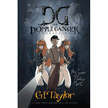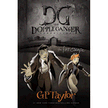I don't actually remember how I first ran across The Dopple Ganger Chronicles by G.P. Taylor about a year and a half ago. I probably either found it in the Christianbook.com catalog or the Lifeway Christian Stores catalog. I don't think I've ever seen anything quite like these books before. They're not a novel in the traditional sense; many parts of the story are told in graphic novel format. But they aren't strictly graphic novels either, because there are many pages that are filled partly or completely with standard text, like a novel. If you flip through one of them, it almost looks like a very stylish novel with cartoon-style illustrations, but if you think you can read the story and skip the pictures, you're wrong. When the narrative ends at a cartoon section, it actually picks up in the cartoon! It's a great format for a book targeted at tween readers, even ones who are reluctant to read for pleasure. My then 9-year-old son enjoyed the first one very much! (He hasn't read book #2 yet, but he's planning to very soon!)
Book #1, The First Escape, introduces us to the main three characters: twin girls named Sadie and Saskia Dopple, and their friend, a boy named Erik Ganger. I should explain, for anyone who doesn't get the joke here, that "doppelgänger" is a word meaning a double or an alter-ego, so there's a "double meaning" to the series title. The girls are "Dopple" and the boy is "Ganger," and the girls are mirror-image twins so each is a doppelgänger of the other. All three of the children are orphans; they live in an orphanage for girls called Isambard Dunstan's School for Wayward Children (Erik lives there as sort of a part-time janitor; all of the other "wayward children" are girls.) The First Escape also introduces us to some other characters who turn up again in the second book: some of Sadie and Saskia's schoolmates, cranky and slightly shady headmistress Miss Rimmer, tyrannical cook Mrs. Omeron, an odd and threatening magician named The Great Potemkin, and, key to the first book, famed author Muzz Elliott. A very mysterious, ghostlike woman named Madame Raphael also appears quite briefly; her part is small in Escape but she plays a more important part in book #2, The Secret of Indigo Moon. I suspect her character will become more and more important as the series continues on.
I enjoyed The First Escape very much... so much that I actually blew through it probably a little more quickly than I should have, maybe missing a few details in the process. These books lend themselves best to reading at a leisurely pace, particularly in the graphic novel sections. The artwork is very stylish and, in some cases, quite detailed; the comic format is often used for action sequences where a lot is going on at once. The first book is sort of a mystery with some ghosts thrown in (most notably a seance which turns out to be a hoax). There's lots of action and lots of peril; the villains spend a lot of time chasing the heroes around in an attempt to kill them, but at the end, things basically turn out fine (more or less). The things that I don't like about the first book are that the story seems a bit unfocused, with two plot streams going on at once but never really dovetailing in a satisfying way, and that the children don't ever come upon an adult that they can truly trust. Madame Raphael almost qualifies, but her part is so brief and her character so unearthly and mysterious that she barely counts. It turns out that Muzz Elliott was probably the adult that the children could have trusted the most, but Muzz is so self-focused and unavailable that the children wind up having nobody to turn to except each other. It's not that there are no grown-ups; there are lots of grown-ups. It's just that most of them are bad guys, or at best, unreliable good or neutral characters.
The Secret of Indigo Moon does better on both counts. At the beginning of this second installment, the two girls have (sort of) been adopted by Muzz, or at least they have a family-style relationship with her, although they still spend a lot of their time living at Isambard Dunstan's School. Muzz does not appear in this story, but her presence as a trustworthy figure, sort of a safe home base, runs throughout. There are other sympathetic adult characters, too: a newspaper reporter named Dorcas Potts, and her uncle, Lord Gervez. I was happy that the young hero and heroines had finally found some people they could trust. It's important that kids understand that adults are not the enemy, and in the first book it almost felt like that to me. Some of the villains from the first book return in the second book, and some new bad guys appear. And Madame Raphael has a much more important part to play; I'll get back to her in a minute.
I enjoyed how this book deepens the characters and their relationships with each other; the world they move about in seems more real and nuanced in Moon than in Escape. Like the first book, this story is about a band of thieves; the girls get separated, Sadie with Erik and Saskia on her own. But the individual stories seem to merge back together in a more satisfying way in book #2 than in book #1; Sadie and Erik's side adventure serves to advance the plot this time, where in the first book it seemed almost contrived, like a way to get the twins separated so Saskia was out on a limb by herself with nobody else to turn to. But to me, the biggest difference has to do with Madame Raphael and her increased role. Before I go into the details I will mention that her identity is left mysterious at the end of the first book, so if you want to avoid spoilers, you might want to quit reading now and return to this review once you've enjoyed the books on their own merits.
In Escape, Madame Raphael doesn't do very much. She mysteriously appears in Saskia's room, gives her an etiquette lesson, leaves her a key with no real explanation, and disappears, and that's pretty much it. But her appearance obviously made a big impact on Saskia, because in book #2, Saskia seems to think of her in religious terms, to the point of praying to her. But she actually appears several times, and by the end of the book she has implied that she is an angel (one of the angels who was present at the birth of Jesus, in fact) and told Saskia that she should not pray to Madame Raphael, but to someone she refers to as The Companion. The approach is soft-spoken and almost mystical, inviting without being demanding, and I think it's quite effective in a book that is as enjoyable for a tween with no religious upbringing at all as it is for a tween who grew up in church. I look forward to finding out how that character develops over time.
Both books contain a quote from a BBC show calling G. P. Taylor "the new C. S. Lewis." I'm not sure there is a direct comparison; the work of both is compelling, but Lewis was never much of an action scene writer, and Taylor doesn't seem to be that much for symbolism, which was a big thing for Lewis. Like Lewis, Taylor is Anglican (although I don't think C. S. Lewis was actually a minister, while Taylor is). Taylor rolls out fiction much more regularly than Lewis typically did; Lewis also wrote many scholarly works and works of apologetics. But Taylor certainly has a gift for engaging and holding his audience's attention, and the hybrid novel/graphic novel format is quite exciting. I have recommended these books to children's librarians, and I would recommend them to any parent of a child who enjoys books containing fantasy elements (Narnia, Harry Potter, Percy Jackson, etc.) But I would even recommend these books to parents of children who do not like to read. The pacing is fast, but the plots are complex enough that they invite you to participate in the story. This is good stuff. I'm looking forward to book #3, The Great Mogul Diamond, scheduled for release in May!
After I wrote and posted this review, I gave the book to my 11-year-old son. He read it immediately, and at the end of two days he had finished it... TWICE! He can't wait for book #3 (and he wants me to buy him the first one, which we got from the library)!
I was provided with a review copy of The Secret of Indigo Moon by Tyndale House Publishers. I read The First Escape before requesting the review copy of Moon. The opinions expressed in this review are mine alone.
Saturday, April 30, 2011
Subscribe to:
Post Comments (Atom)







No comments:
Post a Comment